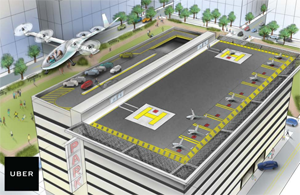
By JENSEN LIM LEONG
Staff Writer
Uber, the company that once started as a small executive car service, has now decided to branch out and try expanding their business model to the skies. The vertical expansion is called Uber Elevate, a new program with the same ride-sharing services that Uber is famous for, but with the unique twist of flying vehicles.
It is important to understand Uber does not plan to make flying cars or VTOLs (Vertical Take-off and Landing, pronounced vee-tol). Instead, this announcement intends to appeal to tech companies who could build these vehicles to work faster. Uber would only continue what they have already done, which is provide a service where a “driver” can be contacted from any place. It is projected that the first VTOL would be operational within five years and available for commercial use within ten years.
Another major appeal of Uber Elevate, besides flying cars, is the speed. Uber Elevate is supposed to cut down traffic times from two hours to 15 minutes. In the sky, any route is feasible compared to highways and streets which dictate the routes one can take from point A to point B.
There are many hurdles that must be jumped before Uber Elevate will see the public eye. First, they must be approved and follow FAA (Federal Aviation Administration) regulations. They also must abide by air traffic control laws to prevent VTOLs from crashing into airplanes or each other. If certain cities have higher air traffic than usual, new rules and guidelines must be put in place accordingly.
The two main concerns are efficiency and affordability. The reason why helicopters are not for public transportation is they make a ton of noise, cost about ten times more than the average car and are extremely inefficient. If pilots are dependent on these VTOLs and the amount of money they can make, then the charge of the battery is an issue. The batteries need to be able to charge as fast as possible, but an electric vehicle would not only cut down on the noise but also the dangerous carbon emissions that many cars have today. Finally, If the price of flying is too outrageous, then Uber loses a huge portion of the market who would rather wait than spend more. Although this does not seem to be a major concern by Uber.
In the public 98-page white paper proposal for Uber Elevate, Uber has said, “We also believe that in the long term, VTOLs will be an affordable form of daily transportation for the masses, even less expensive than owning a car. Normally, people think of flying as an expensive and infrequent form of travel, but that is largely due to the low production volume manufacturing of today’s aircraft.”
Uber believes after VTOLs oversaturate the market their respective prices will also fall, but the operative phrase is “long term”. There is no way to know when the prices of the VTOLs will fall to the point the everyday salaryman can use one on his daily commute.
Another problem is pilot certification. Unlike cars, odds are most people in a city are not pilots but almost everyone is able to drive a car. Uber will not have a problem attracting pilots; the hard part will be getting them trained and ready for the job. They also must be safe while flying these VTOLs, but for now, it is estimated that the VTOLs will be twice as safe as driving with enough time.
Uber Elevate still has a massive advantage over other transportation projects like the Hyperloop. Unlike most public transportation, the need and upkeep of infrastructure like railways or highways are nonexistent. Uber does have one cost and that is Uber wanting to create a network of stations called Vertiports. Vertiports would essentially be hubs of multiple VTOLs that would provide a place for the aircraft to charge.
Uber Elevate has massive support in the tech community not only because of the childhood dream of flying cars but also the practicality and potential. Even if one hates flying heights and rather travel by car or bus, it would be in his or her best interest that Uber Elevate succeeds. Odds are with many in the sky, ground traffic will be cut down and the competition of another public vehicle may cut down car prices. The whole point is the dream of flying cars is not far away. In ten years, the sky may look more like something out of a cyberpunk film.














